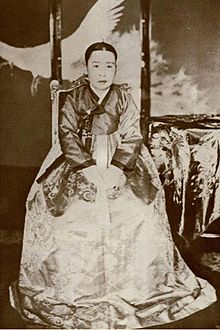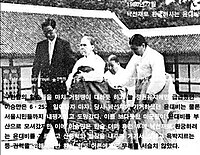Empress Sunjeonghyo
This article needs additional citations for verification. (April 2008) |
| Empress Sunjeong | |
|---|---|
 Empress Sunjeong-hyo in 1909. | |
| Empress consort of Korea | |
| Tenure | 20 July 1907 – 29 August 1910 |
| Predecessor | Empress Myeongseong |
| Empress consort of Korea | |
| Pretender | 29 August 1910 – 24 April 1926 |
| Successor | Crown Princess Euimin |
| Born | 19 September 1894 Hanyang (Seoul), Joseon Dynasty (now South Korea) |
| Died | 3 February 1966 (aged 71) Nakseon Hall, Changdeok Palace, Seoul |
| Burial | |
| Spouse | Sunjong of Korea |
| Father | Yun Taek-yeong |
| Empress Sunjeonghyo | |
| Hangul | 순정효황후 |
|---|---|
| Hanja | 純貞孝皇后 |
| Revised Romanization | Sunjeong Hyo Hwang-hu |
| McCune–Reischauer | Sunjŏng Hyo Hwang-hu |
Empress Sunjeong of the Korean Empire (19 September 1894 – 3 February 1966) was the consort of Emperor Yunghui, the last emperor of the Joseon Dynasty and Korea.
Biography
Early life
Empress Sunjeong was born Lady Yun of Haepyeong in Seoul and her father was Marquis Yun Taek-yeong, the Lord of Haepung. Yun Bo-seon, 2nd president of the Republic of Korea, was her ninth cousin three times removed.
Empress Sunjeong married Crown Prince Cheok after his first wife (known posthumously as Empress Sunmyeong) died. On 20 July 1907, she became Empress of Korea when her husband ascended the throne after the forced abdication of his father, Emperor Gwangmu. The Empress was demoted by the Japanese government by the Japan-Korea Annexation Treaty of 1910 and thereafter officially known as Her Majesty Queen Yi of Korea (this title, however, was ignored in Korea).
Empress Sunjeong became a widow 24 April 1926, when Emperor Yunghui died without issue at the Changdeok Palace in Seoul. Emperor Yunghui had been rendered infertile (and was also said to be mentally disabled) by poisoning in the Coffee Poisoning Plot.[citation needed]
Korean War
During the Korean War, Empress Sunjeong stayed in Changdeok Palace as long as she could in the face of advancing forces from North Korea. During the war, the soldiers of North Korea invaded the palace but she reproved them and drove them all out. She then escaped secretly to the Unhyeon Palace when the war situation became too serious. As the war progressed she moved to Busan with other Imperial family members, including Princess Hui (wife of Prince Wanheung). According to "The World is One", Princess Yi Pangja's autobiography, Empress Sunjeong went to Busan on foot.
After the Korean War

After the war, the new government of President Rhee Syng-man, jealous of the popularity of the Imperial House, prevented Empress Sunjeong from entering the Changdeok Palace. She was kept imprisoned in Suin Hall, a narrow and unsuitable cottage in Jeongneung, Seoul. After a change in government in 1961 she returned to Nakseon Hall, Changdeok Palace with her dutiful ladies-in-waiting Park Chang-bok (d.1981), Kim Myung-gil (d.1983) and Sung Ok-yeom (d.2001), and five other staff.
Empress Sunjeong became a Buddhist in her later years. She died childless on 3 February 1966, aged 72, at Nakseon Hall, Changdeok Palace, Seoul from a heart attack. She was given a state funeral and a private Buddhist funeral. She is buried beside her husband, Emperor Yunghui at the Yureung.
She is known posthumously as Empress Sunjeong of Korea (officially, (純貞孝皇后; 순정효황후; Sunjeonghyo Hwanghu; Empress Sunjeong-hyo).
Titles from birth
- Lady Yun of Haepyung (1894–1906)
- Her Imperial Highness The Crown Princess Cheok of Korea(1906–1907)
- Her Imperial Majesty The Empress of Korea (1907–1926)
- Her Majesty The Queen Yi of Korea (1910–1926)
- Her Majesty The Queen Dowager Yi of Korea (1926–1945)
- Her Imperial Majesty The Empress Dowager of Korea (1926–1966)
- Her Late Imperial Majesty Empress Sunjeong of Korea (Posthumous Title)
